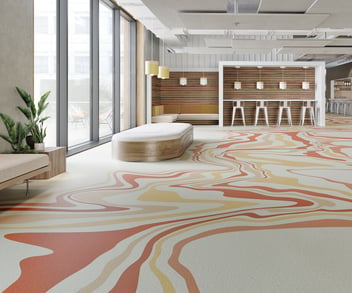
In honor of National Safety Month, can we role-play for a minute? You’re an employee, running into an office building. It’s raining buckets, first day on the job. You wipe your feet after you get through the doors. Searching the lobby… where are the elevators? Found them! Catch the elevator, run in, hit the button, wait for the door to close. You’re going to make it on time. And you didn’t even slip or fall, thanks to the facility manager who worked diligently behind the scenes to ensure the right products were on the floor—keeping you safe, even with your wet shoes. Flooring choices are a key aspect of workplace safety, no matter the type of facility.
Preventing Slips, Trips and Falls
According to the U.S. Bureau of Labor Statistics, 244,000 workplace injuries reported in 2019 were due to slips, trips, and falls. Certain flooring choices can help ensure that workers have more secure passages, walkways, and open gathering areas within your buildings. For heavy-traffic areas, choose floor coverings that are easy to clean and maintain while also being slip-resistant.
In entryways, walk-off systems can prevent 80% of outside soil from being tracked throughout your building. Look for options that can be installed with welded seams to provide a wall-to-wall moisture barrier.

If possible, avoid loose rugs and mats. If you must use a mat to absorb water and dirt by an entrance, ensure it is slip-resistant. If there is a built-in tread pattern for scraping shoes, make sure the tread isn’t too deep, which could increase the chances of tripping.
For corridors and stairwells, it’s important to choose high-performance flooring that will withstand the punishment of harsh elements as well as heavy foot traffic. Rubber flooring and stairwell systems are available in a variety of colors and textures so that you don’t have to forego style and design to maintain the safety of slip resistance.

Improving Accessibility for All
When considering accessibility, it’s critical to think beyond physical accessibility to also include neurodiversity. Flooring can make a significant contribution to visual messaging through patterns, colors and visual texture. Visual cues can help diminish risk and increase safety with patterns and colors providing wayfinding throughout a space. It is critical, however, to always keep your working environment in mind. Colorful, complex patterns can energize a space where creativity is needed; whereas soothing neutrals with subtle patterns are best for spaces that require focus or need to accommodate varying neurodiversities. Simple, sculptured flooring with understated patterns will help reduce visual distraction and assist with sound dampening.

Providing Comfort for Long Hours on Your Feet
For those employees who spend long hours standing, you’ll want to provide some sort of relief. Consider nurse fatigue—it can have a profound impact on adverse patient outcomes, such as medication errors, as well as adverse effects on staff, such as musculoskeletal injuries and job burnout. That type of fatigue easily transfers to other similar “standing” professions—retail, hospitality, government, the list goes on.

A number of flooring options provide ergonomic support while meeting the other performance needs of the space. In some environments, modular and hybrid carpet are a great solution, and extra cushion backing can be added when possible. For healthcare settings, homogeneous or heterogeneous vinyl flooring is more appropriate to cushion underfoot while providing other health and wellness features. In addition, while OSHA does not mandate them, it recommends using anti-fatigue mats for those who work in uncomfortable positions. Keep trip hazards in mind when selecting a mat and its location on the floor.
Improving Acuity
Visual acuity (VA) is “a measure of the ability of the eye to distinguish shapes and the details of objects at a given distance.” Impaired visual acuity is definitely a concern when it comes to trips and falls. Flooring with busy patterns (especially those with medium-sized patterns) and glare from high-sheen surfaces can make navigating spaces especially difficult for aging populations. For some healthcare or senior living facilities, consider opting for solid colors or large patterns with low color contrast. If using a tile or vinyl surface, choose something more matte-finished without a high gloss.

Dissipating Electrostatic Discharges
For rooms full of electrostatic-sensitive devices, the flooring choice is especially critical. Static-dissipative flooring is available (which is a bit more complex than I have room for in this blog), in addition to flooring that receives a post-manufacturing anti-static treatment. If you need specific flooring to help protect against ESDs, it would be best to seek guidance from flooring and electronic professionals, who can ensure your investment is protected all around.

It’s 5:00 Somewhere
That employee made it through their first day on the job. And you’re doing great, too—making all the right flooring choices for workplace safety. There’s a lot to remember, and it changes all the time. Keep up the great work!
Editor's Note: As the director of workplace segment markets for Tarkett North America, Derrell leads the organization’s strategic planning for market growth in corporate offices, life sciences and multi-family projects. He believes collaboration is the key to any organization’s success and is passionate about supporting Tarkett customers with the research and design strategies needed for evolving the future of workplace environments.












.png?width=352&name=Blog%20Graphics%20(18).png)

